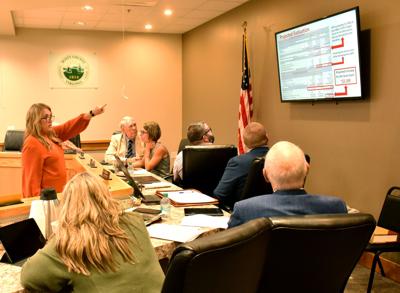GATE CITY – Scott County Supervisors saw that arithmetic may not be simple when gauging taxpayer impact from enrolling Tennessee students in county schools.
District 3 Supervisor Eddie Skeen referred to Monday’s passage of the county’s 2025-26 budget Wednesday, which included $225,000 in unspent school budget money returned to the county to help cover additional EMS funding.
Skeen said the unspent funds came from 2024-25 school system enrollment being below budget projections. He recommended the supervisors start looking at the division’s March average daily membership numbers each year to see if there is excess money to return to the county general fund.
Assistant County Administrator Bill Dingus said the $225,000 was not in school system possession before the end of the fiscal year 2025 budget.
“It’s not money that the school system had and gave back to us,” said Dingus. “It’s money that they didn’t draw down from our general fund.”
Skeen said the new county school budget is more than $70 million but comparable to Wise County’s school budget with approximately 2,000 more students than Scott.
With 421 Tennessee students enrolled in county schools, Skeen claimed that group costs the county $1.5 million or approximately $3,000 per Tennessee student.
District 4 Supervisor Michael Brickey said Tennessee students are competing with Scott County resident students for valedictorian and salutatorian spots as well as positions on school sports teams.
Skeen said Tennessee students make up 24% of enrollment at Yuma Elementary School, 31% at Weber City Elementary, 22% at Gate City High and 21% at Gate City Middle.
Supervisor-at-Large Stephanie Addington said she had researched the local funding issue based on Virginia Department of Education online information about each locality’s composite index. The composite index – which determines a locality’s minimum required level of school; funding — is calculated from four factors, Addington explained with a slide presentation to the board.
Virginia looks at a locality’s total real property value, taxable retail sales and adjusted gross income for both residents only and residents and non-residents, Addington said. The index formula then takes the local school division’s March average daily membership to determine how much the state allocates in basic aid and how much the locality must contribute.
Under the current composite index – calculated for two year periods and effective through June 30 2026 – Addington said Scott County has an index of 0.1878. That translates to the state contributing $84 for every $16 in local funds, or less than a 20% contribution by the county.
Based on a range of 421 to 500 Tennessee students, Addington said charging tuition would remove that group from average daily membership under state guidelines for computing the county’s composite index. That index could climb to 0.2096 – a 21% requirement for local funding – and eliminate approximately $3,000 per student in state basic aid.
Charging tuition would a school board decision, Addington said, but doing so would cost the county another $1.5 million in local funding for schools.
“The only thing that we as a board can and should look at is the implications of (charging tuition),” Addington said.








